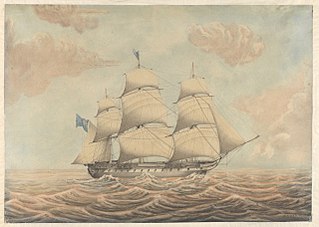
HMS Thetis was a 46-gun Leda-class fifth-rate frigate built for the Royal Navy during the 1810s. She was first commissioned in 1823 and was assigned to the South America Station three years later. The ship was wrecked in 1830 off Cape Frio, Brazil, with the loss of 22 crewmen; most of her cargo of bullion was successfully salvaged.

HMS Arethusa was a 46-gun Leda-class fifth-rate frigate built for the Royal Navy during the 1810s. The ship was never commissioned and was converted into a lazarette in 1836. She was renamed HMS Bacchus in 1844 and was further converted into a coal hulk in 1851–52. The ship was sold for scrap in 1883.
HMS Nereus was a 46-gun modified Leda-class fifth-rate frigate built for the Royal Navy during the 1810s. She was never commissioned and was converted into a store ship in 1843 for service in South America. The ship was sold for into civilian service in 1879.
HMS Thisbe was a 46-gun modified Leda-class fifth-rate frigate built for the Royal Navy during the 1820s. The ship was never commissioned and spent her entire career in reserve or on third-line duties. She was converted into a depot ship in 1850 and then into a floating church in 1863. Thisbe was replaced by a shore-based establishment, All Souls Chapel, in 1891 and sold for scrap the following year.

HMS Nemesis was a 46-gun Seringapatam-class fifth-rate frigate built for the Royal Navy during the 1820s, one of four ships of the Druid sub-class.

HMS Leda was a 46-gun Seringapatam-class fifth-rate frigate built for the Royal Navy during the 1820s, one of seven ships of the Druid sub-class.

HMS Stag was a 44-gun Seringapatam-class fifth-rate frigate built for the Royal Navy during the 1820s, one of three ships of the Andromeda sub-class.
HMS Seahorse was a 44-gun Seringapatam-class fifth-rate frigate built for the Royal Navy during the 1820s, one of three ships of the Andromeda sub-class. After completion in 1830, she was ordered to be converted into a steam-powered ship in 1845, but this did not happen for another decade.
HMS Forth was a 44-gun Seringapatam-class fifth-rate frigate built for the Royal Navy during the 1820s, one of three ships of the Andromeda sub-class. After completion in 1833, she was ordered to be converted into a steam-powered ship in 1845, but this did not happen for another decade.
HMS Frolic was a 10-gun Cherokee-class brig-sloop built for the Royal Navy during the 1810s. She was sold in 1838.
HMS Skylark was a 10-gun Cherokee-class brig-sloop built for the Royal Navy during the 1820s. She was wrecked in 1845.
HMS Spey was a 10-gun Cherokee-class brig-sloop built for the Royal Navy during the 1820s. She was wrecked in 1840.
HMS Pigeon was a 10-gun Cherokee-class brig-sloop built for the Royal Navy during the 1820s. She was sold in 1847.
HMS Wizard was a 10-gun Cherokee-class brig-sloop built for the Royal Navy during the 1820s. She was wrecked in 1859.

HMS Talbot was a 28-gun Atholl-class sixth-rate frigate built for the Royal Navy during the 1820s.
HMS Comus was an 18-gun sloop, the name ship of her class, built for the Royal Navy during the 1820s.

HMS Harrier was an 18-gun Fly-class sloop, built for the Royal Navy during the 1830s.
HMS Peterel was a six-gun Alert-class packet brig built for the Royal Navy during the 1830s.

HMS Penguin was a six-gun Alert-class packet brig built for the Royal Navy during the 1830s.
HMS Persian was a sixteen-gun Acorn-class brig-sloop built for the Royal Navy during the 1830s.








